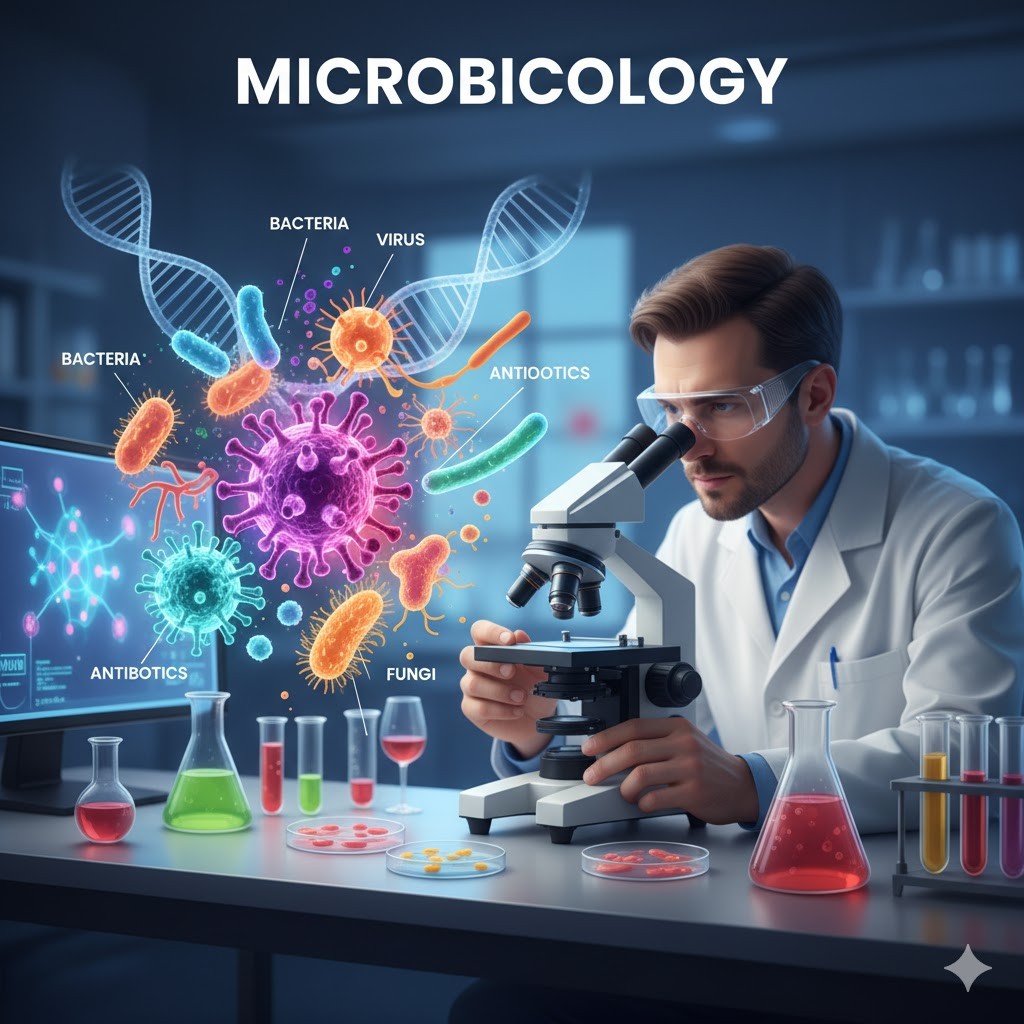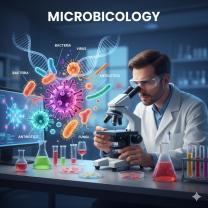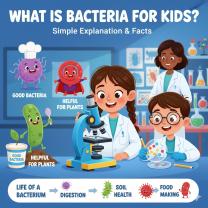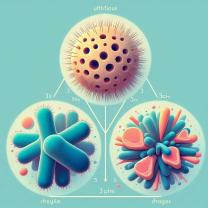What is the introduction of Microbiology?
Microbiology, at its core, is the scientific exploration of the unseen world—the realm of microorganisms.
This fascinating field stands as a cornerstone of both biology and medicine, profoundly influencing our understanding of life itself. From the prevention and treatment of infectious diseases to the groundbreaking advancements in biotechnology, microbiology continually reshapes our capabilities and perspectives.
In this comprehensive overview, we will delve into the essence of microbiology, exploring its fundamental definitions, key branches, and the compelling historical journey that brought it to its current prominence. We will also examine the myriad of applications these microscopic entities have in modern life, revealing why the study of the very small is so critical to the grand scheme of our existence.
What Is the Introduction of Microbiology?
Microbiology is defined as the scientific study of microorganisms, which are broadly understood as any organism too small to be seen without the aid of a microscope.
The term "microorganism" itself is a broad classification, bringing together an incredibly diverse group of entities.
At its heart, microbiology seeks to understand how these minute life forms grow, reproduce, evolve, and interact within their ecosystems. It explores their metabolic processes, genetic makeup, and the myriad ways they influence health—both beneficially and detrimentally—and shape the environment around them. This understanding is key to harnessing their positive aspects and mitigating their negative ones.
Why Is Microbiology Important in Science?
The importance of microbiology in the broader scientific landscape cannot be overstated. It underpins crucial advancements and sustained efforts across a multitude of disciplines, including medicine, agriculture, food production, and environmental protection.
In natural ecosystems, microbes are the unseen engineers of life.
The real-world relevance of microbiology is profoundly felt. It is central to the development of life-saving vaccines that protect against infectious diseases, and the discovery and production of antibiotics that combat bacterial infections. In the food industry, microbes are indispensable for processes like the fermentation of bread, cheese, yogurt, and alcoholic beverages.
What Are the Main Branches of Microbiology?
The vastness and diversity of the microbial world have led to the development of numerous specialized branches within microbiology, each focusing on specific types of microorganisms or particular aspects of their study.
Here are the key subfields:
Bacteriology: This branch is dedicated to the study of bacteria, single-celled prokaryotic organisms.
Bacteriologists investigate their morphology, genetics, biochemistry, and ecology, as well as their roles in disease and beneficial processes. Virology: Virology is the scientific discipline concerned with viruses, obligate intracellular parasites that are much smaller than bacteria.
Virologists study their structure, classification, evolution, replication mechanisms, and the diseases they cause. Mycology: This field focuses on fungi, which include yeasts, molds, and mushrooms.
Mycologists study their diversity, physiology, genetics, and their impact on humans (e.g., fungal infections) and the environment (e.g., decomposition, symbiosis). Parasitology: Parasitology is the study of parasites, which include protozoa (single-celled eukaryotes) and helminths (worms) that live on or in another organism and derive nutrients at the host's expense.
Immunology: While often considered a distinct field, immunology is closely intertwined with microbiology.
It is the study of the immune system and how it protects the body from disease, particularly from microbial invaders. Environmental Microbiology: This branch investigates the role and diversity of microorganisms in natural and artificial environments, including soil, water, and air.
It examines how microbes influence nutrient cycling, pollution remediation, and ecosystem health. Industrial Microbiology: This applied field focuses on harnessing microorganisms for industrial purposes, such as the production of pharmaceuticals, enzymes, food products, biofuels, and other biotechnological applications.
These branches are not isolated; they frequently collaborate and overlap in addressing global challenges like emerging pandemics, antibiotic resistance, and environmental pollution.
How Did Microbiology Develop as a Field of Study?
The journey of microbiology from a realm of invisible speculation to a robust scientific discipline is a testament to human curiosity and ingenuity. Its history is marked by revolutionary discoveries and technological advancements.
The birth of microbiology is largely attributed to Anton van Leeuwenhoek in the 17th century.
However, it wasn't until the 19th century that microbiology truly began to flourish as a coherent field. The pivotal contributions of Louis Pasteur and Robert Koch were instrumental in establishing the germ theory of disease.
Major milestones continued to accumulate: the development of sterile techniques, the discovery of antibiotics (famously penicillin by Alexander Fleming in 1928), and the advent of cell culture techniques revolutionized the study and control of microorganisms.
What Are the Applications of Microbiology in Daily Life?
The influence of microbiology extends far beyond scientific laboratories, permeating numerous aspects of our daily lives, often in ways we take for granted. Its practical applications are vast and varied.
In healthcare, microbiology is foundational. It's crucial for the production of vaccines that prevent infectious diseases and the diagnosis of illnesses through microbial culture and molecular techniques. The ongoing battle against bacterial infections relies heavily on the continuous development and judicious use of antibiotics.
The food industry is another sector profoundly shaped by microbiology.
Agriculture benefits immensely from microbial activities.
In the realm of the environment, microbiology offers powerful solutions. Bioremediation utilizes microorganisms to break down pollutants and toxic waste in contaminated soil and water, offering an eco-friendly approach to environmental cleanup.
Finally, in research and biotechnology, microorganisms are invaluable tools. They are used to produce enzymes for industrial processes, synthesize vital pharmaceuticals like insulin, and are at the forefront of gene editing technologies such as CRISPR-Cas9, which originated from a bacterial immune system.
It's critical to understand that while many microbes are beneficial, others can be harmful.
Conclusion
In summary, microbiology is far more than just the study of invisible creatures; it is a cornerstone of science that profoundly influences virtually every facet of modern life.
The study of microorganisms not only equips us with the knowledge and tools to combat devastating diseases and maintain public health, but it also drives innovation across a spectrum of industries.
For students, aspiring scientists, and anyone with a curious mind, microbiology offers a gateway to understanding the fundamental connections between life, science, and technology. It encourages a deeper appreciation for the unseen forces that shape our world and holds immense promise for addressing the complex challenges and opportunities of the future.
FAQ Section
Q1: Who is known as the father of microbiology?A1: Anton van Leeuwenhoek is widely regarded as the "Father of Microbiology" for his pioneering work in observing and describing microorganisms using his self-made microscopes in the 17th century.
Q2: What are the most common microorganisms studied in microbiology?A2: The most commonly studied microorganisms include bacteria, viruses, fungi (like yeasts and molds), and protozoa.
Q3: How does microbiology help in developing new medicines?A3: Microbiology helps in medicine development by identifying disease-causing pathogens, enabling the creation of vaccines and antibiotics, and utilizing microbes (or their products) for the production of therapeutic drugs like insulin and other biologics.
Q4: What are some examples of beneficial microbes?A4: Beneficial microbes include the bacteria in our gut that aid digestion, yeast used in baking and brewing, bacteria that fix nitrogen in soil for plant growth, and microorganisms used in wastewater treatment and bioremediation.
Q5: What’s the difference between microbiology and biotechnology?A5: Microbiology is the fundamental study of microorganisms.












CuriousMind
on October 12, 2025The FAQ section was a nice touch, answering common questions about 'microbiology' effectively.